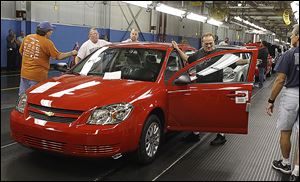
DEFECT CONFIRMED AT MAY 2009 MEETING
GM told staff of fatal flaw, kept word from victims’ kin
3/25/2014
Workers at the Lordstown, Ohio, Assembly Plant work on the Chevrolet Cobalt in 2008. The next year GM engineers were informed data in the Cobalt’s black box showed an ignition switch fault.
DETROIT — It was nearly five years ago that any doubts were laid to rest among engineers at General Motors about a dangerous and faulty ignition switch. At a meeting on May 15, 2009, they learned that data in the black boxes of Chevrolet Cobalts confirmed a potentially fatal defect existed in hundreds of thousands of cars.
But in the months and years that followed, as an expanding trove of internal documents and studies mounted, GM told the families of accident victims and other customers that it did not have enough evidence of any defect in their cars, interviews, letters and legal documents show. Last month GM recalled 1.6 million Cobalts and other small cars, saying that if the switch was bumped or weighed down it could shut off the engine’s power and disable air bags.
In one case, GM threatened to come after the family of an accident victim for reimbursement of legal fees if the family did not withdraw its lawsuit. In another instance, it dismissed a family with a terse, formulaic letter, saying there was no basis for claims.
“We sent the paperwork for the car to them and they said there’s nothing to this,” said Neil Kosilla, whose daughter, Amy, 23, died in a Cobalt accident in March, 2010, after the air bags failed to deploy. “They said we had nothing.”
Since the engineers’ meeting in May, 2009, at least 23 fatal crashes have involved the recalled models, resulting in 26 deaths. GM reported the accidents to the government under a system called Early Warning Reporting. It requires automakers to disclose claims they receive blaming vehicle defects for serious injuries or deaths.
A New York Times review of 19 of those accidents — where victims were identified through interviews with survivors, family members, lawyers, and law enforcement officials — found that GM pushed back against families in at least two of the accidents, and reached settlements that required the victims to keep the discussions confidential.
In other instances, GM ignored repeated calls, families said.
“We did call GM,” said Leslie Dueno, whose son, Christopher Hamberg, 18, was killed on June 12, 2009 — not quite a month after the critical May 15 meeting of GM engineers about the ignition data. He was driving his 2007 Cobalt home before dawn in Houston. He lost control at 45 mph and hit a curb, then a tree, the police report said. “Nobody ever called me. They never followed up. Ever,” Ms. Dueno said.
Last month’s recalls of the Cobalt and five other models covered model years 2003 through 2007. GM faces numerous inquiries, including one by the Justice Department looking into the company’s disclosures in its 2009 bankruptcy filing and what it told regulators.
“We are conducting an unsparing, comprehensive review of the circumstances leading to the ignition switch recall,” GM said in a statement Monday. “As part of that review, we are examining previous claims and our response to them. If anything changes as a result of our review, we will promptly bring that to the attention of regulators.”
The company has said it has evidence of 12 deaths tied to the switch problem, but it has declined to give details other than to say they all occurred in 2009 or earlier. It says it has no conclusive evidence of more recent deaths tied to the switch.
“We are doing our best to get this right, which means reviewing the data with care,” the company said in its statement. “Not every Cobalt accident is a result of a faulty ignition switch.”
It was unclear how many of the 26 deaths since the 2009 meeting were related to the faulty ignition, but some appeared to fit patterns that reflected the problem, such as an inexplicable loss of control or air bags that did not deploy. In some cases, the drivers had put themselves at risk, including having high blood-alcohol levels or texting.
Still, by the time Benjamin Hair, 20, crashed into a tree in Charlottesville, Va., on Dec. 13, 2009, while driving a Pontiac G5 home, GM had conducted five internal studies about the ignition problem, company records indicate. Though Mr. Hair was wearing his seatbelt, he died after the car’s air bags failed to deploy. His parents were baffled. “The police couldn’t tell us what caused the accident,” said Brenda Hair, his mother. The Hairs contacted GM for answers, providing accident reports but no vehicle data, because the car’s black box had been destroyed. “They came back and said they’d presented it to their board of engineers, and they couldn’t say it was related” to a defect, Brenda Hair said.
By then, employees who knew about the switch problems ranged across the company, from its legal offices at headquarters in Detroit to its test tracks and research labs outside the city. GM attorneys had known of one fatal Cobalt accident in 2005, and had settled or worked on several cases. GM’s sales department had issued two service bulletins to dealers related to faulty switches, advising them to tell customers to drive without heavy key chains that could jostle the ignition and shut down the car.
On the manufacturing side, the ignition switch as well as the key had been modified for new cars in the middle of model production in late 2006 or early 2007 — an unusual move for such a high-volume part.
By summer 2010, GM had ended production of Cobalts.